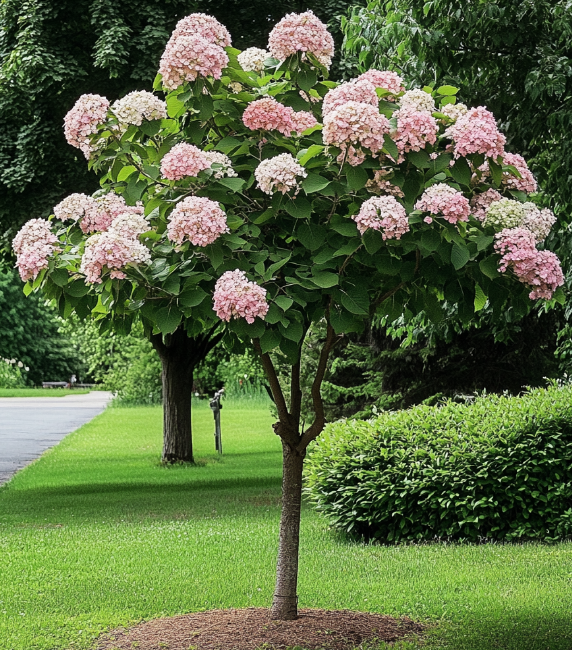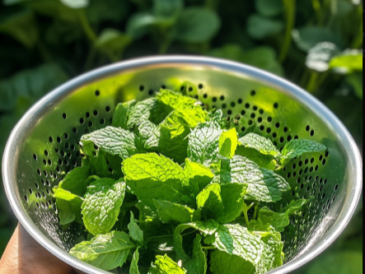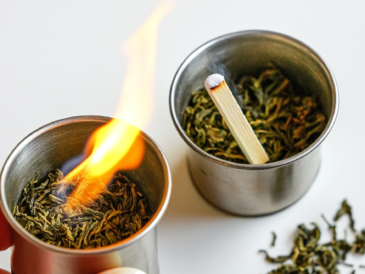Part 1: How to Grow a Hydrangea Tree – The Stunning Strawberry Vanilla Variety
Introduction to the Strawberry Vanilla Hydrangea Tree
The Strawberry Vanilla hydrangea tree is a show-stopping addition to any garden. Known for its cone-shaped blooms that transition from creamy white to soft pink and deep red as the season progresses, it resembles scoops of strawberry and vanilla ice cream. While hydrangeas are often associated with shrubs, they can also be pruned and trained to form captivating small trees, ideal as focal points in your landscape. This guide will take you through everything you need to know about growing and caring for the unique Strawberry Vanilla hydrangea tree.
What is a Hydrangea Tree?
A hydrangea tree is essentially a shrub that has been meticulously pruned and trained to grow with a single, sturdy trunk, giving it the appearance of a small tree. The Strawberry Vanilla hydrangea (Hydrangea paniculata ‘Renhy’) is particularly well-suited for this due to its upright growth habit and breathtaking blossoms.
Benefits of Growing a Hydrangea Tree
- Aesthetic Appeal: Adds vertical interest and serves as a unique focal point in your garden.
- Long Blooming Season: Blooms from mid-summer to early fall.
- Cold-Hardy: Thrives in USDA zones 4–8, making it suitable for a wide range of climates.
- Pollinator-Friendly: Attracts bees and butterflies, enhancing your garden’s ecosystem.
How to Plant a Strawberry Vanilla Hydrangea Tree
1. Choose the Right Location
- Light Requirements: Hydrangea trees do best in full sun to partial shade. Aim for 4–6 hours of sunlight daily.
- Soil: Prefers well-drained, loamy soil rich in organic matter. Avoid areas prone to waterlogging.
- Space: Ensure at least 6–8 feet of space around the tree for optimal growth and air circulation.
2. Prepare the Soil
- Test Soil pH: Hydrangeas prefer slightly acidic to neutral soil (pH 6.0–7.0).
- Add Compost: Mix compost or well-rotted manure into the planting site to boost fertility and drainage.
3. Planting Steps
- Dig a Hole: Create a hole twice as wide and the same depth as the root ball.
- Position the Tree: Place the tree in the hole, ensuring the top of the root ball is level with the ground.
- Backfill: Use a mix of native soil and compost, gently tamping down to remove air pockets.
- Water Thoroughly: Water well to help settle the soil.
Part 2: Caring for and Maintaining Your Hydrangea Tree
1. Watering
- Consistent Moisture: Keep the soil moist but not waterlogged. Water deeply once or twice a week, adjusting based on weather conditions.
- Mulching: Use mulch around the base to retain moisture and regulate soil temperature.
2. Fertilizing
- Spring Feeding: Apply a balanced, slow-release fertilizer in early spring.
- Avoid Over-Fertilizing: Excessive fertilizer can result in lush foliage with fewer blooms.
3. Pruning
- Timing: Prune in late winter or early spring before new growth begins.
- Technique: Remove dead or weak branches to promote healthy blooms. Shape the canopy by trimming growth below the main structure.
4. Pest and Disease Management
- Common Pests: Watch for aphids and spider mites. Treat infestations with insecticidal soap or neem oil.
- Prevent Fungal Issues: Ensure good air circulation and avoid overhead watering to prevent diseases.
How to Train a Hydrangea into a Tree Form
If you’re starting with a young shrub, follow these steps:
- Select a Strong Stem: Choose the most upright, vigorous stem to serve as the trunk.
- Remove Competing Stems: Trim away other stems at the base.
- Stake the Trunk: Use a stake to keep the trunk straight as it grows.
- Shape the Canopy: Let the top branch out naturally while maintaining a single trunk below.
Tips for Vibrant Blooms
- Seasonal Pruning: Deadhead spent blooms to encourage new flowers.
- Sunlight Balance: Ensure the tree receives adequate sunlight, as too much shade can hinder flowering.
- Winter Care: Protect roots with a layer of mulch during freezing temperatures.
Common Problems and Solutions
1. Lack of Flowers
- Cause: Over-pruning, insufficient sunlight, or poor soil nutrients.
- Solution: Adjust the tree’s light exposure and fertilize appropriately.
2. Yellowing Leaves
- Cause: Overwatering or nutrient deficiencies.
- Solution: Improve soil drainage and apply balanced fertilizer.
3. Wilting
- Cause: Underwatering or heat stress.
- Solution: Increase watering during hot spells and add mulch to retain moisture.
Landscaping Ideas with a Hydrangea Tree
- Standalone Feature: Plant as a stunning centerpiece in your garden or lawn.
- Border Accent: Line pathways or driveways with hydrangea trees for a formal touch.
- Companion Plants: Pair with perennials like hostas, lavender, or astilbes for a lush, layered effect.
Conclusion
The Strawberry Vanilla hydrangea tree is a beautiful and easy-to-care-for addition to any garden. With proper planting, pruning, and care, you can enjoy its captivating blooms year after year. Whether you’re an experienced gardener or a beginner, the hydrangea tree is sure to elevate your outdoor space with its charm.
FAQs
1. Can I grow a hydrangea tree in a pot?
Yes, but use a large container with proper drainage and ensure it receives adequate sunlight and water.
2. How long does it take to train a hydrangea into a tree?
It typically takes 2–3 years to train a hydrangea into a tree form.
3. When is the best time to plant a hydrangea tree?
Spring or fall is ideal for planting as temperatures are mild, allowing roots to establish.
4. How tall does a Strawberry Vanilla hydrangea tree grow?
It typically grows 6–8 feet tall when mature.
5. Can I propagate a Strawberry Vanilla hydrangea tree?
Yes, propagation can be done through cuttings or layering in early spring.




